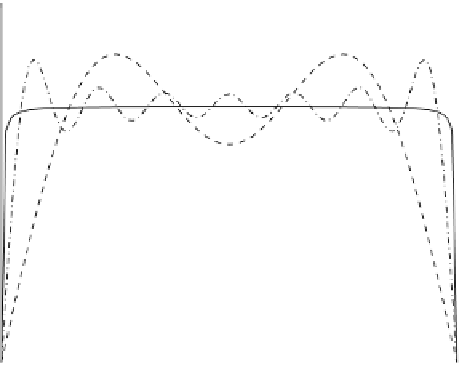Information Technology Reference
In-Depth Information
14
12
10
8
6
4
2
0
0
0.1
0.2
0.3
0.4
0.5
0.6
0.7
0.8
0.9
1
Fig. 8.1
The first two (
dashed line
), seven (
dash-dotted line
), and 100 (
solid line
)termsofthe
Fourier sine series of the function f.x/
D
10
Thus we find that the Fourier sine series of this function is
X
40
.2k
1/
f.x/
D
10
D
sin..2k
1/x/
for x
2
.0; 1/;
(8.81)
k
D
1
see (8.75).
In Fig.
8.1
we have plotted the N th partial sum of this series for N
D
2; 7; 100.
The alert reader might have noticed a subtle difficulty in the Fourier analysis
presented above. Every sine mode, sin.kx/, is zero at x
D
0 and at x
D
1,
provided that k is an integer. Consequently, any function g given by a Fourier sine
series, finite or infinite,
X
1
g.x/
D
c
k
sin.kx/;
k
D
1
will also have the property that
g.0/
D
g.1/
D
0:
Thus, (8.75) cannot, in general, be extended to hold at the end points of the closed
unit interval Œ0; 1; convergence toward f.x/ is only obtained for x
2
.0; 1/.In
addition, the convergence tends to be slow close to the endpoints of the interval, see
Fig.
8.1
. On the other hand, if f is a well-behaved function satisfying
f.0/
D
f.1/
D
0;
(8.82)





































